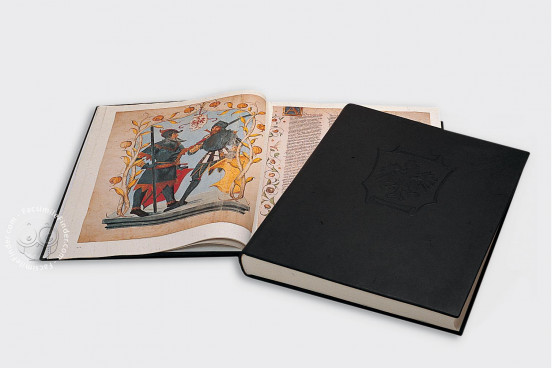The Ambras Book of Heroes is a significant work in the tradition of high and late medieval German epic poetry. It encompasses numerous Middle High German epics, among them the Nibelungenlied, Hartmann’s Erec and Iwein, and Ulrich of Lichtenstein’s Frauenbuch, all valuable basic texts for medieval research. The scribe Hans Ried, customs officer on the Eisack near Bolzano, copied the Book of Heroes for King Maximilian I who had ordered it for his own use.
This "giant book", as it was also called because of its oversized format (406 x 360 mm) and for which no less than 122 calves had lost their skins, is fascinating due to the accomplished beauty of its script which has been executed in uniform lettering from the first to the last page. 118 of the manuscript’s 486 pages (243 folios) are ornate with elaborately painted initials and with imaginative marginal decoration, making it also a unique document for the history of art.
A masterpiece of calligraphy
The Ambras Book of Heroes was written out in German cancelleresca script masterly executed by the experienced calligrapher Hans Ried. Its unified form which is maintained throughout the entire book lends the script a particular character, and it deserves to bear its own name in scribal history as the script of the Book of Heroes.
The overall impression of Ried’s handwriting is also characterised by the numerous, frequently hair fine diacritic marks which often puzzled those who had to transcribe texts from the Ambras Book of Heroes by use of film or partial copies reduced in size. The facsimile version in the original format thus constitutes a valuable replacement of the manuscript.
Writing down the Ambras Book of Heroes took over twelve years, a very long period of time, even for a manuscript of such huge dimensions. Ried was therefore reproached as being a "clever lazybone", a reproach which, however, seems unjustified, as he was not only concentrating on accomplishing the Book of Heroes alone. Moreover, the experienced calligrapher put great diligence into the script and the elaborate decoration of the first and last lines of each page, so that we may estimate a maximum performance of probably three columns (= one page) per day.
The decorative apparatus
The numerous small initials were added at a later stage, perhaps by a special rubricist, whereas the large initials were executed by one painter in a single pass. They are painted in various colours, mostly red or blue, on golden, finely patterned grounds. Some initials are executed in blazing gold upon a coloured background.
The imaginative ornamentation which decorates 118 pages of the book is loosely dispersed across the broad margins. Numerous plants and animals which impress the beholder by their naturalistic and detailed execution, as well as depiction's of human figures, betray the hand of an experienced master who seems to have derived some of the motives in free variation from books of hours of the Low Countries.
The marginal decorations serve as decorative embellishment and are sometimes closely linked to the contents, such as on fol. 212v where the depiction of a sword broken on the scale armour of a dragon illustrates the relevant text on the same page.
The frontispiece of the Ambras Book of Heroes shows two men in harness, probably the heroes guarding the entry to the book named after them. An immediate reference to the commissioner and later owner of the manuscript is the depiction of pomegranates, one of Maximilian’s inscribed emblems, which might be interpreted as symbolic metamorphoses of the orb, in allusion to the world’s domination by the emperor.
We have 1 facsimile edition of the manuscript "Ambras Book of Heroes": Das Ambraser Heldenbuch facsimile edition, published by Akademische Druck- u. Verlagsanstalt (ADEVA), 1973
Request Info / Price

